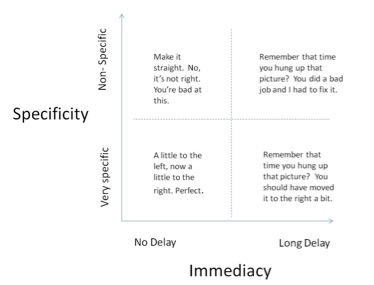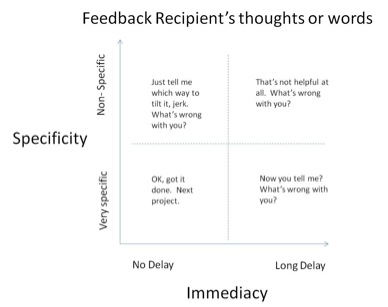The Art of Providing Feedback: Make it Specific and Immediate
Providing Feedback is a neglected art in people management. It is neglected because many managers would prefer to avoid providing feedback to their employees. It’s not necessarily the most natural thing to do, and it can be easily avoided. However, if you are a manager, you need to provide performance feedback to your employees. If you aren’t doing it in some capacity, then you are not meeting the minimum bar of being the manager. Time to break the habit of neglecting this art!
Now, how to make your feedback more artful! There are two important dimensions that make providing feedback—whether it’s praise or corrective—more artistic. The feedback that you provide should strive to be both specific and immediate. The more specific and the more immediate, the more artfully you’re providing feedback, and the more likely you’re going to improve the performance of your employees. In contexts outside the workplace, this concept is intuitive. Let’s work through a simple example:
Someone is helping you hang up a picture. As part completing this simple task, you provide specific and immediate feedback: “A little to the right, no, a little to the left. OK, that’s good. Perfect. Good job in getting this done and thanks for helping me out!” (Note that this has both corrective feedback, and praise for good work. It’s possible—note that the praise happens after the objective has been obtained).
This is very artful feedback. Now let’s look at the feedback without specificity or immediacy:
The lower left quadrant has specific and immediate feedback. You get the results you want, and there is no resentment by the one receiving feedback. In fact, it is expected by the person helping you out. In the less artful versions of providing feedback, you are guaranteed to get some pretty weird looks and probably some angry talkback from the person who’s trying to help you:
In any quadrant other than the lower left, you’re going to have the reaction of “What’s wrong with you?” from the person you’re working with. There will probably be many other angry and confused thoughts beyond what is documented here. On the plus side, the specific and immediate feedback in the lower left corner results in quality work, motivation to move on to the next thing, and interpersonal relationships are intact and perhaps even stronger!
In my next article, we’ll see how this looks in a more “workplace-like” scenario.
Have you ever received feedback that was ill-timed or vague? What was your reaction? Have you ever tried to give feedback that was too late or seemed vague? How did it feel?
The Manager by Design blog provides twice-weekly people management tips and discussion on the emerging field of Management Design. If you are looking for ideas on how to be a better manager of people and teams, subscribe to Manager by Design by Email or RSS.
Related posts:
An example of giving specific and immediate feedback and a frightening look into the alternatives
The Art of Providing Feedback: At least try to describe what to do instead
Providing corrective feedback: Trend toward tendencies instead of absolutes
How to use behavior-based language to lead to evaluation and feedback
Behavior-based language primer for managers: How to tell if you are using behavior-based language
Behavior-based language primer for managers: Avoid using value judgments
Behavior-based language primer for managers: Stop using generalizations





Comments
18 Responses to “The Art of Providing Feedback: Make it Specific and Immediate”Trackbacks
Check out what others are saying about this post...[…] my previous post, I introduced the idea that the more specific and more immediate the performance feedback you […]
[…] […]
[…] […]
[…] Manager by Designsm blog discusses the art of providing feedback, such as making your feedback specific and immediate and attempting to describe the preferred […]
[…] […]
[…] Now you can provide performance feedback on the spot to Alex that is both specific and immediate: […]
[…] short, a manager should not provide performance feedback on items that are indirect and removed from direct observation of an employee’s […]
[…] […]
[…] […]
[…] […]
[…] The Art of Providing Feedback: Make it Specific and Immediate […]
[…] […]
[…] […]
[…] (Ignore for a moment that this feedback does not meet the standard of being “specific and immediate”.) […]
[…] […]
[…] The Art of Providing Feedback: Make it Specific and Immediate […]
[…] […]
[…] […]